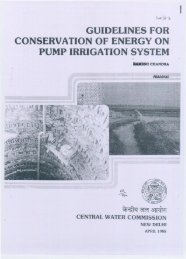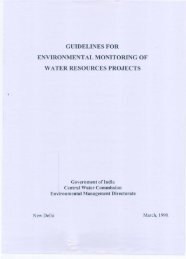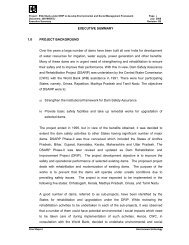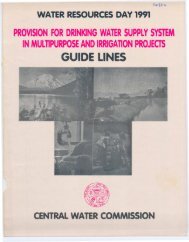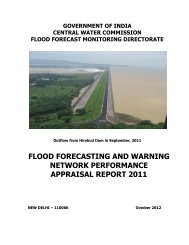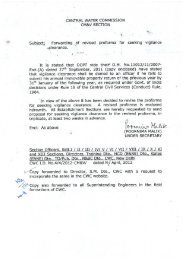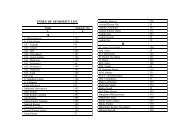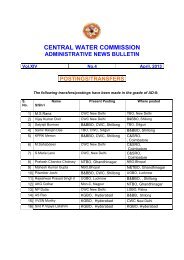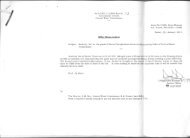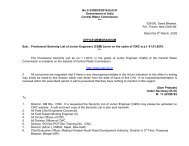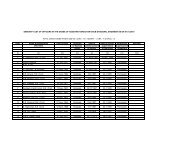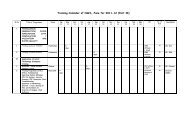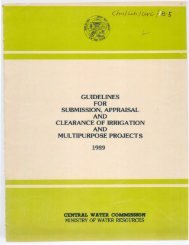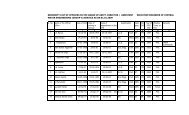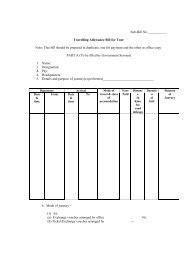Guidelines for Safety Inspection of Dams - Central Water Commission
Guidelines for Safety Inspection of Dams - Central Water Commission
Guidelines for Safety Inspection of Dams - Central Water Commission
You also want an ePaper? Increase the reach of your titles
YUMPU automatically turns print PDFs into web optimized ePapers that Google loves.
storage, or lower when appropriate. For projects where the<br />
bottom <strong>of</strong> surcharge space is not distinct or the flood control<br />
storage space (exclusive <strong>of</strong> surcharge) is appreciable, it may be<br />
appropriate to select starting water surface elevations below the<br />
top <strong>of</strong> the flood control storage <strong>for</strong> routings. Conservatively high<br />
starting levels should be estimated on the basis <strong>of</strong><br />
hydrometeorological conditions reasonably characteristic <strong>for</strong> the<br />
region and flood release capability <strong>of</strong> the project. Necessary<br />
adjustment <strong>of</strong> reservoir storage capacity due to existing or future<br />
sediment or other encroachment may be approximated when<br />
accurate determination <strong>of</strong> deposition is not practicable.<br />
4.3.3 Acceptable procedures<br />
Techniques <strong>for</strong> per<strong>for</strong>ming hydraulic and hydrologic analyses are<br />
generally available from publications prepared by <strong>Central</strong> / State<br />
agencies involved in water resources development or text books<br />
written by the academic community. Some <strong>of</strong> these procedures<br />
are rather sophisticated and require expensive computational<br />
equipment and large data banks. While results <strong>of</strong> such procedure<br />
are generally more reliable than simplified methods, their use are<br />
generally not warranted in studies connected with this<br />
programme unless they can be per<strong>for</strong>med quickly and<br />
inexpensively. There may be situations where more complex<br />
techniques have to be employed to obtain reliable results.<br />
However, these cases will be exceptions rather than the rule.<br />
Whenever the acceptability <strong>of</strong> procedures is in question, the<br />
advice <strong>of</strong> competent experts should be sought. Such expertise is<br />
generally available in the <strong>Central</strong> <strong>Water</strong> <strong>Commission</strong>, India<br />
Meteorological Department and National Institute <strong>of</strong> Hydrology.<br />
4.3.4 Freeboard allowances<br />
<strong>Guidelines</strong> on specific minimum freeboard allowances are not<br />
considered appropriate because <strong>of</strong> the many factors involved in<br />
such determinations. The investigator will have to access the<br />
critical parameters <strong>for</strong> each project and develop its minimum<br />
requirements. Many projects are reasonably safe without<br />
freeboard allowances because they are designed <strong>for</strong> overtopping,<br />
or other factors minimize possible overtopping. Conversely,<br />
freeboard allowance <strong>of</strong> several feet may be necessary to provide<br />
a safe condition. Parameters that should be considered include<br />
the duration <strong>of</strong> high water levels in the reservoir during the<br />
design floods, the effective wind fetch and reservoir depth<br />
available to support wave generation; the probability <strong>of</strong> high wind<br />
speed occurring from a critical direction; the potential wave run-<br />
17



